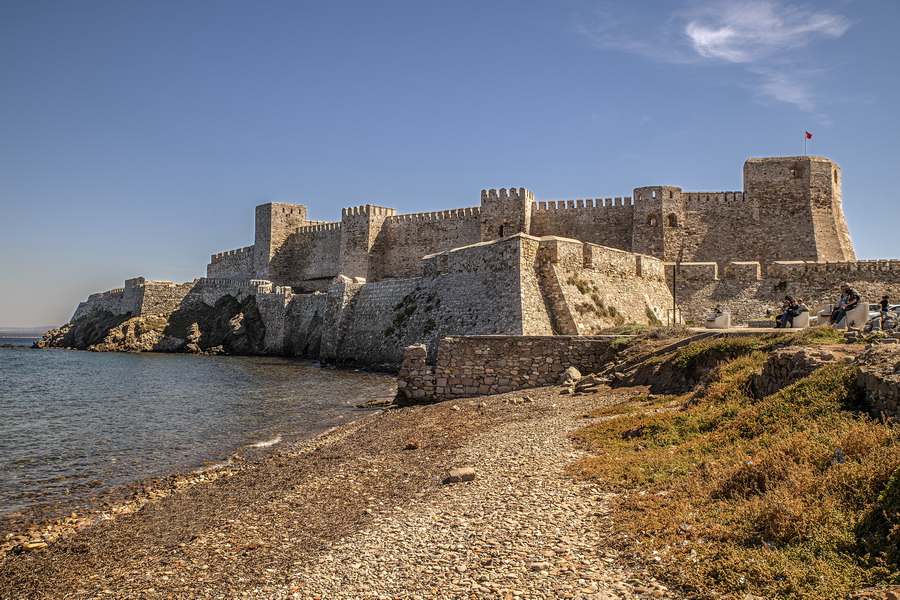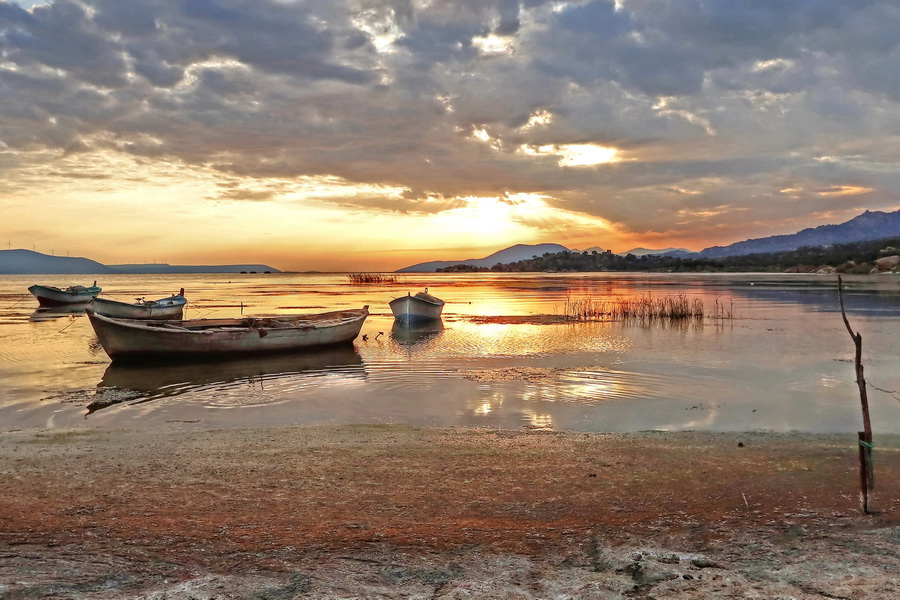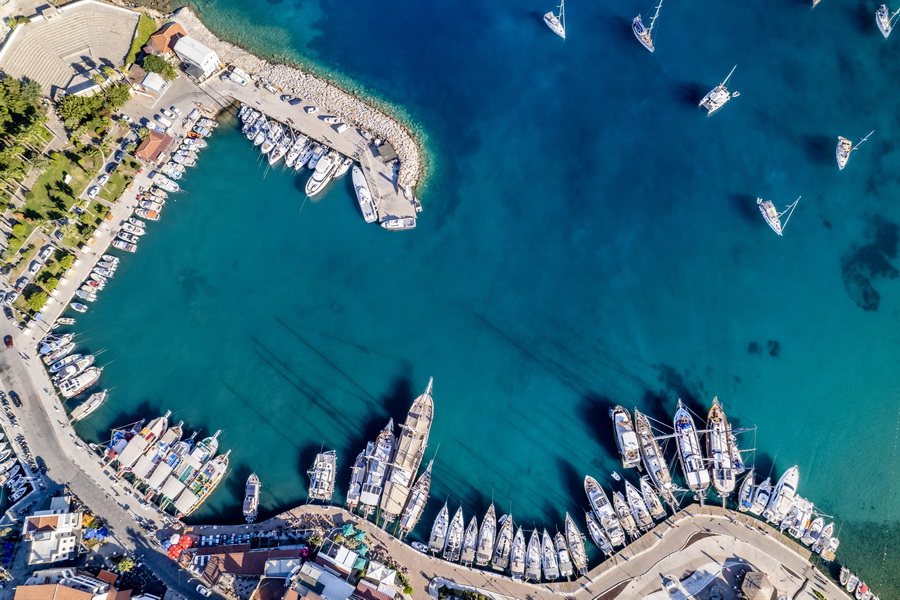- 1. Turkish Aegean Region tours
- 2. Best time to visit the Aegean Region
- 3. Uncover the charms of the 8 provinces
- 4. Explore the history of the Aegean Region
- 5. Plan your dream holidays in the Aegean Region
- 6. Marvel at nature's wonders in outdoor activities
- 7. Green escapes: ecoregions and sustainable destinations
Promoted as the Coast of Happiness by the Ministry of Culture and Tourism of Turkey (Türkiye), the Aegean Region (Ege Bölgesi) is the western edge of Asia Minor, wrapped in glowing beaches, tremendous historic landmarks and peaceful seaside towns. Stretching from Çanakkale to Muğla, this region flawlessly interpenetrates favoured nature, diverse history and serene coastal holidays.
Where the roaring waves meet ancient stones, the Turkish Aegean unfolds a coastline shaped by centuries, where once Ionian cities flourished, philosophers contemplated the universe and the rhythm of life has always moved with the tides.
Ephesus (Efes), Pergamon, and Miletus (Milet) defined the civilisations. The Great Theatre of Ephesus and Library of Celsus guard the wisdom of epochs. Just beyond, in the hills of Aydın and Muğla, the remnants of temples and agoras remain, untouched by time, standing as silent witnesses to empires that came and went.
Yet the Turkish Aegean is more about the living, breathing landscape of sun-drenched beaches, wind-kissed waves and coastal towns where life moves in peace. Alaçatı’s narrow alleys, shaded by bougainvillaea, lead to stone houses now home to boutique cafés and art galleries. In Ayvalık, fishermen return at dusk, their boats heavy with the day’s catch, ready to be served alongside Aegean mezes and local wines on waterfront tables.
Turkish Aegean Region Tours

The Aegean Region of Turkey is where history, nature and the sea converge. Travellers can sail gulets along Muğla’s coast, dive into the waters of Çanakkale, paraglide over Babadağ, cycle through Marmaris or ride the wind while kitesurfing in Akyaka. The mellow and laid-back feel is everywhere – small fishing villages, olive groves, and streets shaded by bougainvillaea. Izmir and Bodrum combine old and new, with lively markets, sedate bays, and restaurants serving fresh seafood with local wines.
Additionally, the region combines dynamic business centres with world-class leisure spots. Izmir, Turkey’s third-largest city, hosts international trade fairs organised by İZFAŞ with quick access to shoreline spots. The İzmir Chamber of Commerce reports growing foreign investment in manufacturing, logistics, and tech.
Bodrum attracts high-profile conferences at luxury resorts, while its marina serves as a yachting hub. The Milas-Bodrum Airport (BJV) connects to major European cities, making it a practical choice for business travellers. Post-work, explore ancient sites like Halicarnassus or private beach clubs.
Efficient transport links – Adnan Menderes Airport (ADB) in İzmir, Milas-Bodrum Airport, and high-speed trains – make combining work and play convenient. The Aegean’s mix of industry, history, and coastline ensures productivity and downtime coexist without difficulty.
Best Time to Visit the Aegean Region

Having the “best climate in the world” (Herodotus), the best time to visit the Aegean Region of Turkey is April-May and mid-September to the end of October because of the reduced number of tourists and perfect temperature, both for swamping yourself in the delightful sea or sightseeing marvelous ancient destinations. In these months, travellers will experience pleasant warmth which is ideal for cultural tours, exploring historical sites and simply enjoying the charming streets of Aegean cities.
Summer is the busiest time, attracting both local and international visitors to Aegean holiday destinations. The region's beaches, including those in Çeşme, Bodrum and Kuşadası, are at their liveliest, and nightlife flourishes with seaside clubs, open-air concerts and festivals. However, temperatures can rise above 35°C (95°F). Those interested in Aegean cultural tours and historical sites may find the spring and fall months more suitable.
For budget-conscious travellers, the off-season from December to mid-March is the most economical time to visit, though cooler temperatures and occasional rain make outdoor activities less appealing. Some coastal areas slow down in winter, with seasonal businesses closing. However, this is a great time for experiencing local traditions and quieter Aegean cities.
The sea is generally warm enough for swimming from mid-May to mid-October. Water activities such as diving and sailing are best between May and September when coastal marinas are active with Aegean cruises. Meanwhile, shopping in bazaars is more worthwhile in spring, before the summer rush, when selections are broader and bargaining is easier.
For history, nature or relaxation, choosing the right season ensures the best experience in the Aegean Turkey.
Uncover the Charms of the 8 Provinces in the Turkish Aegean Region
The region has eight geographical areas, covering approximately 11% of the country’s total land area. It stretches along the western coast, bordered by the Marmara Region to the north, the Mediterranean to the south and Central Anatolia to the east. Because of the longest coastline in Turkey, the region is one of the major destinations for summer vacations.
The region consists of eight provinces: Izmir, Aydın, Muğla, Manisa, Denizli, Uşak, Kütahya and Afyonkarahisar. Each province has unique geographical qualities, from coastal plains to mountainous landscapes. The coastline is shaped by deep bays, peninsulas and islands, while inland areas have a lush lowland. Mountains such as Kaz, Bozdağ and Aydın run perpendicular to the shore, allowing the sea air to reach further inland.
The region’s diverse geography plays a key role in shaping its tourism appeal, from the brightly coloured city life of Izmir to the serene coastline of Muğla.
Explore the History of the Turkish Aegean Region

Way before written history, the Luwians and later the Hittites inhabited parts of the Aegean, though the city of Troy or Troya (3000 - 1200 BC) – celebrated in Homer’s Iliad – initially placed the region on the world’s historical map.
In the first thousand years BC, Greek settlers established prosperous city-states along the Aegean coast. Ephesus, Miletus and Smyrna (now Izmir) defined the path of Western philosophy and science. Miletus, in particular, was home to Thales, Anaximander, and Anaximenes. The Kingdom of Lydia, with its capital at Sardis, produced the world’s first coins.
By 546 BC, the Persian Empire had extended its rule over the region, but this dominance was short-lived, as in 334 BCE, Alexander the Great smashed Anatolia, liberated the Greek cities from Persian control and guided in a new Hellenistic era. The kingdom of Pergamon lodged the illustrious Pergamon Library, second only to Alexandria’s.
As the Romans took control in 133 BC, the Aegean’s success reached new heights. Ephesus became a metropolis, known for architectural phenomenons such as the Library of Celsus (Celsus Kütüphanesi) and the Temple of Artemis (Artemis Tapınağı), one of the Seven Wonders of the Ancient World.
After the fall of Rome, the Byzantine Empire controlled the Aegean region for nearly a thousand years. In the 11th century, the Seljuk Turks arrived, bringing new architectural and cultural influences, particularly in towns like Alaşehir and Denizli. By the 14th century, the rising Ottoman Empire absorbed the Aegean Region, making Izmir one of the most important port cities in the kingdom.
Following World War I, Greece occupied the region, leading to the Greco-Turkish War (1919–1922), in which Turks won, causing the relocation of Greeks and Turks to their respective new nations.
With the founding of the Republic of Turkey in 1923, the Aegean Region entered a new chapter. Today, it harbours numerous archaeological areas, including numerous UNESCO World Heritage sites.
Plan your Dream Holidays in the Aegean Region of Turkey

One can hardly get bored in the glowing lands of the Turkish Aegean Region, as an assortment of fascinations vary from paragliding adventures to cultured historical tours, delivering both luxury and budget-friendly experiences.
From ancient monuments to spectacular coastal towns, the Aegean Region makes a prime destination for cultural tours and seaside delights equally.
With its integration of history, nature and leisure activities, the Aegean Region is an ideal holiday destination for all kinds of travellers.
Historical splendours and holy sites
History lovers can visit ancient cities like Ephesus, an ancient city that once rivalled Rome in size and importance. Among the Temple of Artemis, you will find the Celsus Library and the Great Theatre, and the Ephesus Terrace Houses that showcase well-preserved mosaics and frescoes.
Troy and the ruins of Miletus and Priene, which are dotted with temples, theatres and agoras. In Izmir, the Kadifekale fortress and the Agora of Smyrna (İzmir Agorası or Smyrna Agorası) stand as proof of antiquity.
At present, in Pergamon you will encounter the Acropolis, steep amphitheatre and a historically significant library.
Designed by Greek architects, the Mausoleum at Halicarnassus in Bodrum rose 45 m high, adorned with sculptures. This Wonder of the Ancient World, was destroyed by earthquakes. The term “mausoleum” originates from it.
Sardis (Sart), the former capital of the Lydian Kingdom, is another key historical site where visitors can see remains of a Roman gymnasium, Lydian-era relics and an early Christian church from the Seven Churches of Revelation.
Another iconic site is the Gallipoli Peninsula (Gelibolu Yarımadası), a place of deep historical significance due to the World War I battle that shaped modern Turkish, Australian and New Zealand identities.
Not far from Ephesus lies the House of the Virgin Mary (Meryem Ana Evi), believed to be where Mary spent her final years.
Enchanting cultural cities
Beyond historical sites, the Aegean coastline champions charming towns and beautiful sea views. Akyaka, a lesser-known gem, provides crystal-clear waters and traditional Ottoman-style houses.
On cultural tours one can explore the traditional villages, local markets and lively city centres of places like Ayvalık, Alaçatı, and Bodrum.
Izmir, one of the largest cities in the region, shelters the famous Izmir Clock Tower (Saat Kulesi), the Agora Open Air Museum and Konak Square in full swing, also available with MuseumPass Türkiye.
The TCDD Open-Air Steam Locomotives Museum near Selçuk presents a fascinating collection of historical train cars, while the Bodrum Museum of Underwater Archeology stores artefacts from the Bronze Age.
Yachting and cruising
The Aegean coast of Turkey is a top destination for sea-activity enthusiasts with its clear waters and well-equipped marinas. Key ports like Bodrum, Marmaris and Göcek serve as major boat rental locations, providing modern yachts and professional services. Sailing conditions are ideal, with steady meltemi winds in summer and sheltered anchorages near ancient sites like Ephesus and Knidos. The coastline features secret little bays, lively beach clubs and traditional fishing villages, having varied stops along a sailing route.
Wellness and health tourism
For a more relaxed experience, the region’s thermal springs, such as those in Pamukkale, deliver natural spa treatments with healing waters. Visitors can also relax at Aydıncık Beach’s natural mud baths, providing various health benefits.
Marvel at Nature's Wonders and Delight in Outdoor Activities

Sometimes referred to as an open-air museum, the region is additionally favoured by Mother Nature, supplying a myriad of outdoor activities and landmarks.
Hiking trails
For those who prefer nature, the Aegean’s national parks and islands are worth exploring. Dilek Peninsula-Büyük Menderes National Park near Kuşadası is perfect for hiking, birdwatching and photography.
- Running along the Aegean coast, the Aegean Trail connects towns with beautiful sea and landscape views.
- The Bodrum Peninsula features routes to secluded beaches, ancient ruins and villages.
- Near Selçuk, the Çamlık Trail combines nature and history, including views of Ephesus.
- Kaz Dağları (Mount Ida) celebrates lush forests, biodiversity and scenic trails.
- Extending into the Aegean, the Phrygian Way links ancient sites.
Adventure and extreme sports
The region’s coastline is known for its crystal-clear waters and beautiful beaches. Places like Çeşme, Bodrum, and Ölüdeniz are excellent for water adventure sports such as scuba diving and sailing or extreme sports such as paragliding and canyoning. For canyoning enthusiasts, Köprülü Canyon presents thrilling routes through narrow gorges, waterfalls and natural pools. Adrenaline seekers can also experience skydiving in Bodrum, with tandem jumps opening up breathtaking views of the Aegean Sea.
The Büyük Menderes and Gediz Rivers shape the land and feed fertile plains. Adventure seekers can raft on the Dalaman River or the Köprülü River, known for its exciting white-water rapids. Mountain biking enthusiasts can traverse the Dilek Peninsula’s varied trails or tackle the rugged terrain of Kaz Dağı (Mount Ida).
For off-roading, Bodrum and Fethiye serve up ATV adventures through stunning landscapes. Rock climbers will find challenging routes in Geyikbayırı near Antalya or the dramatic cliffs near Assos. Those looking for a mix of nature and adventure can bike through Kazdağları National Park, layered with myths and endemic flora.
Fishing
Among the region’s lakes, Bafa stands out with its rock paintings and trekking routes, providing peaceful lakeside breakfasts, fishing opportunities and boat trips. Here, you can fish for strong bass and sly catfish while your boat drifts on quiet water. It’s the kind of place where time moves slowly, and the only sounds are the birds and the splash of your line.
If you prefer the open sea, the waters in Bodrum are full of colourful sea bream, powerful grouper and clever octopus hiding among the rocks. In Çeşme, the sea is so clear you can see fish swimming below, while fishing trips in Kuşadası take you far from shore, where the water gets deep and the fish grow larger.
In terms of rivers, the Menderes River winds through the countryside; its gentle currents hide catfish and other freshwater fish.
Green Escapes: Ecoregions and Sustainable Destinations

The Aegean Region of Turkey is an elected domicile of assorted landscapes, ranging from verdant forests to rocky coastlines. These areas host a mix of Mediterranean, Euro-Siberian and Irano-Turanian flora, bringing exceptional biodiversity and fauna.
Cittaslow
For travellers looking to explore nature while supporting sustainability, Izmir stands out as Turkey’s first Cittaslow-designated metropolitan city. Cittaslow (meaning "slow city") is a movement that advocates for a slower, more mindful way of living by prioritising quality of life, preserving local traditions and embracing sustainability.
The region’s eco-friendly destinations include Uzbaş Arboretum, where visitors can observe a wide variety of plant species, and Urla’s vineyards, known for organic wine production. Seferihisar, the first Cittaslow town in the country, lives with a slower pace and sustainable tourism practices. Birgi and Buldan provide opportunities to experience rural life where you will also see Birgi’s mansion and experience the unmatched tradition of Buldan cloth weaving.
Must-See Major Islands
The Aegean coast of Turkey encompasses several islands, each with its incomparable charm and natural beauty.
Gökçeada (Imbros), Turkey’s largest island, is known for its marvellous seashore, unspoiled landscapes and another Cittaslow designation. Visitors can explore traditional villages like Kaleköy and Zeytinli, and witness dazzling sunsets from Uğurlu Village. The island is also notable for its organic farming and rich marine life, making it an ideal spot for ecotourism.
Historically known as Tenedos, Bozcaada is famous for its vineyards, well-preserved architecture and crystal-clear waters. The island grants excellent conditions for outdoor activities such as cycling, hiking and scuba diving. Polente Lighthouse, a popular spot for watching the sundown, and the island’s tranquil beaches form Bozcaada as a year-round destination. Wine lovers can enjoy locally produced wines made with indigenous grape varieties while exploring the traditional cobblestone streets lined with historic houses.
These islands, along with the region’s protected forests and sustainable travel options, provide visitors with opportunities to connect with nature and its sensations.
Unearth Other Natural Wonders of the Turkish Aegean
The Aegean Region of Turkey is characterised by an elegant compound of mountains, lakes, rivers and ancient trails with unparalleled landscapes and outdoor activities. The Bozdağ Mountains in Izmir host ski facilities and scenic plateaus, while the pine-covered Madra Mountains are ideal for hiking and camping. Yunt Mountains, home to the ancient city of Aigai, advance historical exploration alongside nature, while Acıgöl, a saline lake, attracts birdwatchers for its flamingos.
Reconnect with Nature by Experiencing Farm Stays and Agrotourism

Fancy resorts can hardly compare to the simple charm of Turkey’s countryside. Here, farm stays have been part of local life for centuries. Those who look for more than just beaches and hotel perks will find a deeper experience here. Life moves with the land’s natural rhythm, valuing tradition over artificial luxury.
Beyond Gökçeada’s ecotourism gems, places like Vadi Alaçatı, Barbaros Farm, and the Aegean’s charming farm stays guarantee mesmerising rural escapes. Travellers today seek authentic, sustainable experiences, while farm stays deliver olive groves, vineyards, and orchards where you can pick fresh produce or learn traditional methods. The Aegean’s olive oil farms and organic vineyards, agrotourism in the region integrate culture, nature, and hands-on learning.
Guests can press olives, taste local wines, join cooking classes, or even try their hand at cheesemaking. Additionally, these stays support local economies, preserving traditions while giving travellers a deeper connection to the land.
Embrace Sustainable Shopping: Enjoy Eco-Friendly Finds
Distinguished for the long-standing tradition of handcrafted goods, in the Turkish Aegean Region destinations, craftspeople continue to produce ceramics, embroidery and woven textiles using age-old techniques.
Bergama is famous for its hand-knitted carpets, known for their deep red tones and symbolic patterns. Ödemiş, particularly the village of Birgi, has been a centre for silk weaving since the 15th century. In Izmir, you can find traditional quilting, felting and Iznik-style pottery. Buying directly from masters supports local craftsmanship while preserving cultural heritage.
In Izmir’s Kızlarağası Han Bazaar, an 18th-century Ottoman inn, you can track down custom-made jewellery, textiles and earthenware. Alaçatı Bazaar, open on Saturdays, combines fresh farm produce with local textiles and lacework. Tire Bazaar, with its 600-year history, is a must-visit for traditional saddles, tin products and lace.
Marmaris is known for its lively Grand Bazaar, where merchants sell everything from leather goods and carpets to accessories. For gold and silver jewellery, Marmaris Gold Center and Vogue Jewellery showcase exquisite mastery. Nearby, Authentic Bag and Shoes retails handmade leather accessories and watches. If you prefer open-air markets, Içmeler Wednesday Market and the Market Area in Fethiye assemble local farmers, textile vendors and other local professionals selling wood carvings and decorative ceramics.
A Taste of Tradition: Savour Regional Authentic Food

As the land of olive groves, fresh seafood and long-lived culinary traditions, regional food, restaurants and local chefs along this coast of happiness are as remarkable as the positionality of the region through history and geography, with its herbal breakfasts of Assos and Edremit and the meze-laden tables of Cunda and Izmir. Locals start their day with Ezine cheese, olives and oven-fresh bread, often paired with regionally sourced olive oil.
In Edremit, dishes like ot kavurma (sautéed herbs in olive oil) and şevketibostan (St. Benedict’s thistle) emphasise how the area depends on fresh and seasonal ingredients. Seafood dominates the coastal menus, with papalina (small fish unique to Ayvalık) and grilled octopus in Assos being local favourites. Bergama bears its own specialities, such as Bergama köftesi (meatballs) and patlıcan çığırtma (aubergines cooked in olive oil and tomatoes). Heading south, Muğla caters dishes like döş dolması (stuffed lamb ribs) and tarhana soup, a traditional fermented grain soup.
Your ultimate high-gastronomy experience
For a true taste of luxury, Aegean caters modern Turkish cuisine for fine gourmet dining experiences with authentic culinary delights where the local tradition and global tastes are in perfect harmony in magical settings.
For a modern take on Aegean cuisine, top restaurants include The Red Balloon Yalıkavak in Bodrum – which has been included in the MICHELIN Guide as a selected restaurant – where North Aegean flavours meet contemporary techniques. Another notable entry in the very same guide is the newly awarded one-star restaurant Narımor in Izmir, known for its distinctive Turkish cuisine. Additionally, Aslında Meyhane, a Bib Gourmand-recognised restaurant in Urla, serves elevated meze in a relaxed setting.
Wine tasting tourism
The Urla Aegean Wine Trail (Urla Bağ Yolu) must be a pure desire for wine lovers with its world-class Turkish wines. Nestled near Izmir, this sun-drenched peninsula has produced wine since ancient times, and today, boutique wineries are putting it back on the map. The trail connects 10 family-run vineyards, where you can enjoy bold reds, crisp whites and rare local varieties while soaking in views of olive groves and vine-covered hills.
Wineries like pastoral Urlice and modern Urla Şarapçılık host tastings in idyllic settings, often paired with wood-fired pizzas or local cheeses. Some even name their wines after Shakespeare sonnets.
Olive oil sampling sensory experience
In this olive oil heartland of Turkey, ancient orchards and modern production methods establish some of the world’s finest oils. Here, the flavours are golden, peppery, sometimes buttery, and always alive. Around Ayvalık, centuries-old trees produce oils with a bright, herbaceous kick, while Datça’s organic groves champion cleaner, greener notes. In Aydın and Muğla, tradition meets innovation, creating complex and layered profiles.
Tastings here unfold in sun-drenched villages, amid the hum of presses, with fresh and crusty bread and locals eager to share stories to teach you the oil’s soul, its fruitiness and its bite. It’s a sensory journey through time, terrain and patience. And like good wine, the best oils carry the taste of the land itself: wild, generous and unmistakably Aegean.
Indulge in the Vibrant Local Festivals of the Turkish Aegean Region
The rich variety of festivals in the region that celebrate history, culture, nature and gastronomy brings an exclusive perspective on local life.
At Izmir Organic Life Festival (İzmir Organik Yaşam Festivali), experts teach guests how to prepare healthy, organic meals, while the Didim Vegan Festival showcases plant-based cuisine with cooking workshops and ethical discussions. Chocolate enthusiasts flock to the Izmir Chocolate & Dessert Festival (İzmir Çikolata & Tatlı Festivali) for tastings and creative events. Meanwhile, the Alaçatı Herb Festival (Alaçatı Ot Festivali) points up Aegean cuisine with dishes made from fresh domestic herbs.
For centuries, the Manisa Mesir Paste Festival (Mesir Macunu Festivali) has upheld a historic tradition, distributing the famous herbal paste linked to Ottoman healing practices. The International Bayındır Flower Festival (Uluslararası Bayındır Çiçek Festivali) turns the town into a sea of colours. The Urla Scarecrow Festival (Urla Korkuluk Festivali), held in Barbaros village, is a special cultural event that combines environmental awareness with art and rural heritage.
Music and arts also do well here. The Bodrum Jazz Festival (Bodrum Caz Festivali) and International Gümüşlük Classical Music Festival (Uluslararası Gümüşlük Klasik Müzik Festivali) bring world-class performances to picturesque settings. The International Bodrum Ballet Festival (Bodrum Uluslararası Bale Festivali) captivates audiences with performances at ancient venues like Bodrum Castle, while the International Izmir Festival (Uluslararası İzmir Festivali) melts into music, theatre and dance.
Cinema lovers gather for the International Izmir Short Film Festival (Uluslararası İzmir Kısa Film Festivali), featuring global and local productions.
More traditional events include the Selçuk Camel Wrestling Festival (Selçuk Deve Güreşlerİ Festİvalİ), where decorated camels compete in an age-old spectacle. Spring festivals across Kuşadası and other Aegean cities provide lively celebrations as nature awakens. The Kuşadası Youth Festival (Kuşadası Gençlik Festivali), known for its "Always Good Music" slogan, attracts young crowds with energetic performances.
How to Reach the Captivating Aegean Region of Turkey?

Reaching the Aegean Region of Turkey is easy and joyful with multiple travel options. The quickest way is by plane – flights from Istanbul, Cappadocia or Antalya land in Izmir, with budget-friendly or luxurious airlines.
From Izmir, taxis, public transport, or private drivers can take you to key destinations.
For a picturesque journey, an overnight train from Istanbul to Izmir is a relaxed alternative.
Buses provide a budget-friendly option, taking around 12 hours from Istanbul with fares between $30 and $60. If flexibility is your priority, renting a car or hiring a driver lets you explore Aegean holiday destinations at your own pace.
Ferries connect the Greek Aegean Islands to Turkey, with routes from Chios to Çeşme and Pythagorio to Kuşadası among the most popular. Travel times range from 20 minutes to 1.5 hours, and car ferries are available. Schedules vary by season, so booking in advance ensures the best rates.
The Coast of Happiness tells stories beneath its waves, Lycian shipwrecks on its shores, and sun-bleached ruins. The Meltemi winds carry tales of old voyages, lost and found.


